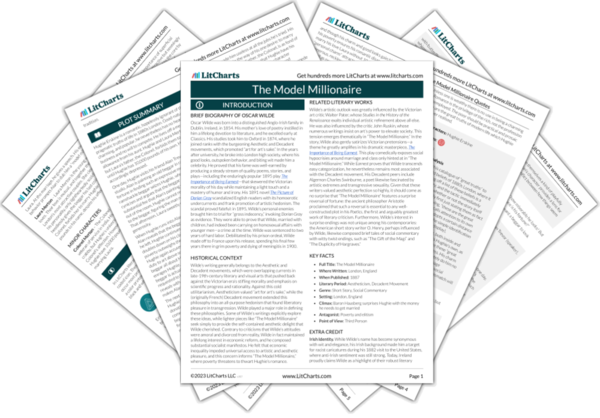“The Model Millionaire” is full of deceptive appearances. Physical attractiveness goes a long way in late-19th-century London society: Hughie Erskine’s good looks make him widely admired, but he lacks brilliance and ambition. His friend Alan Trevor, meanwhile, is an unattractive “strange rough fellow” but a brilliant artist who reaps financial success from his work. Although the characters seem to invest themselves in the idea that appearances bring themselves to bear on wealth and success, the lives they lead don’t necessarily support this idea. In fact, the story challenges the notion that appearances count for much at all.
Hughie and Alan disagree over the true reality of what they see, specifically in the case of a beggar modeling for Alan’s painting. Hughie laments the man’s poor condition, but Alan replies, “What you call rags I call romance. What seems poverty to you is picturesqueness to me.” The idea here is that Alan aesthetically romanticizes suffering and hardship while Hughie considers the reality of such things and what it would be like to actually experience them. Yet the whole debate rests on a false appearance: the beggar model is actually the millionaire, Baron Hausberg, who commissioned the portrait. Alan’s apparent cynicism thus turns out to be an accurate description of Hausberg’s own romantic request.
Ultimately, the story undercuts the importance of superficial things like appearance or status, as the attractive but seemingly insubstantial Hughie shows himself to be good to the core by giving the disguised Hausberg his last sovereign. And Hausberg, in turn, eschews typical wealthy pretensions and greed by handsomely repaying Hughie, thus proving himself a “model millionaire.” Hughie’s fortunate outcome demonstrates that, for Wilde, what matters is how people behave, not necessarily how they present themselves.
Appearance vs. Reality ThemeTracker

Appearance vs. Reality Quotes in The Model Millionaire
He had gone on the Stock Exchange for six months; but what was a butterfly to do among bulls and bears?
Trevor was a painter. Indeed, few people escape that nowadays. But he was also an artist, and artists are rather rare.
“Poor old chap!” said Hughie, “how miserable he looks! But I suppose, to you painters, his face is his fortune?”
“Certainly,” replied Trevor, “you don’t want a beggar to look happy, do you?”
“It’s all very well, Hughie, for you to talk, but I assure you that there are moments when Art almost attains to the dignity of manual labour […].”
“Poor old fellow,” he thought to himself, “he wants it more than I do, but it means no hansoms for a fortnight”; and he walked across the studio and slipped the sovereign into the beggar’s hand.
“An artist’s heart is his head,” replied Trevor; “and besides, our business is to realise the world as we see it, not to reform it as we know it. A chacun son métier”
“The old man you saw to-day in the studio was Baron Hausberg. He is a great friend of mine, buys all my pictures and that sort of thing, and gave me a commission a month ago to paint him as a beggar. Que voulez-vous? La fantaisie d’un millionnaire!”
“I suppose he has come for an apology,” said Hughie to himself; and he told the servant to show the visitor up.
“Millionaire models,” remarked Alan, “are rare enough; but, by Jove, model millionaires are rarer still!”











